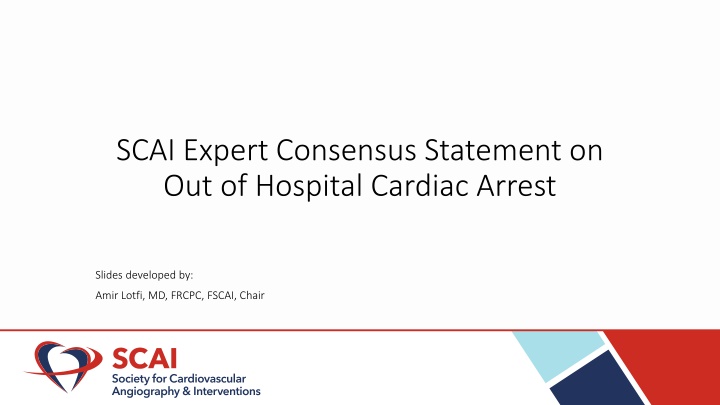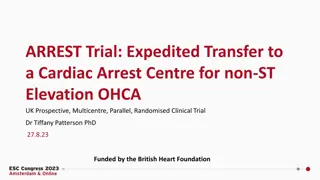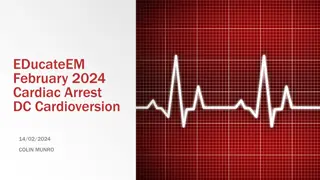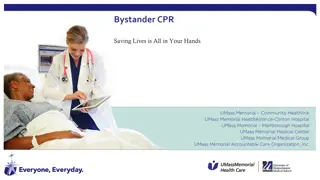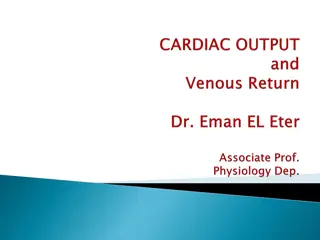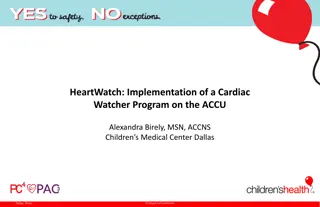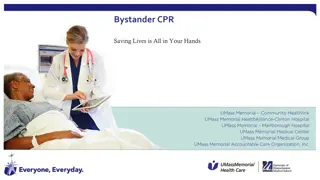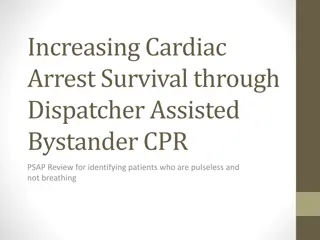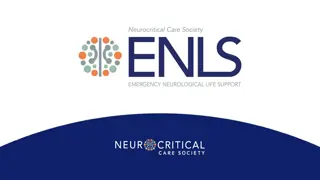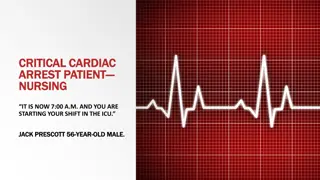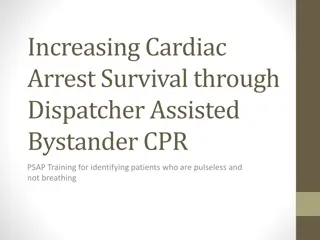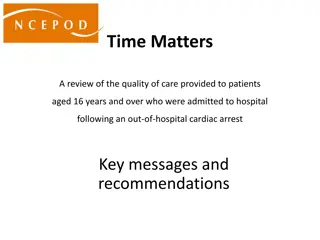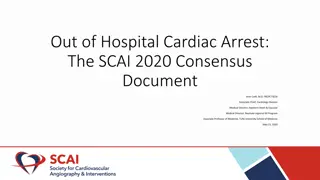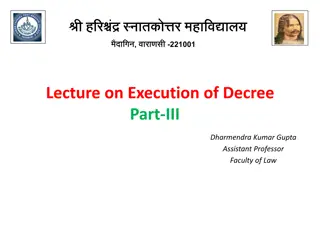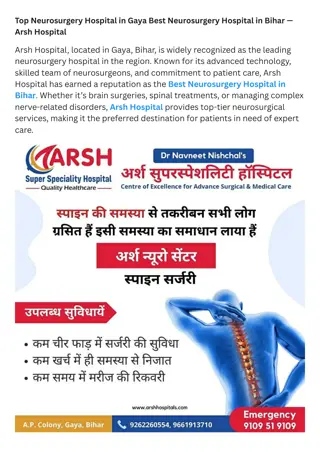Expert Recommendations for Out-of-Hospital Cardiac Arrest Management
Out-of-hospital cardiac arrest (OHCA) is a significant public health concern with high mortality rates. This expert consensus statement led by Dr. Amir Lotfi provides evidence-based recommendations for managing OHCA patients with shockable rhythms and return of spontaneous circulation (ROSC), aiming to improve outcomes and guide interventional cardiologists in their care.
Download Presentation

Please find below an Image/Link to download the presentation.
The content on the website is provided AS IS for your information and personal use only. It may not be sold, licensed, or shared on other websites without obtaining consent from the author.If you encounter any issues during the download, it is possible that the publisher has removed the file from their server.
You are allowed to download the files provided on this website for personal or commercial use, subject to the condition that they are used lawfully. All files are the property of their respective owners.
The content on the website is provided AS IS for your information and personal use only. It may not be sold, licensed, or shared on other websites without obtaining consent from the author.
E N D
Presentation Transcript
SCAI Expert Consensus Statement on Out of Hospital Cardiac Arrest Slides developed by: Amir Lotfi, MD, FRCPC, FSCAI, Chair
SCAI Expert Consensus Statement on Out of Hospital Cardiac Arrest Amir Lotfi MD, FSCAI (Chair); Lloyd W. Klein MD, MSCAI (Vice- Chair); Ravi S. Hira MD, FSCAI; Jaya Mallidi MD, MHS; Roxana Mehran MD, MSCAI; John C. Messenger MD, FSCAI; Duane S. Pinto MD, MPH, FSCAI; Michael R. Mooney MD, FSCAI; Tanveer Rab MD, FSCAI; Demetri Yannopoulos MD, FSCAI; Sean van Diepen MD, MSc Lotfi, A, Klein, LW, Hira, RS, et al. SCAI expert consensus statement on out of hospital cardiac arrest. Catheter Cardiovasc Interv. 2020; 1 18. https://doi.org/10.1002/ccd.28990
Out of Hospital Cardiac Arrest OHCA remains a significant public health problem with high mortality and morbidity Interventional cardiologists are often consulted on OHCA patients with shockable rhythm and ROSC This statement aims to provide evidence-based and patient-oriented recommendations for the management of these patients
Background Annual incidence of EMS-assessed OHCA 347,322 Location home or residence in 69.5%; Nursing home 11.7% Witnessed by layperson 37% Survival to discharge 10.4% with good functional status 8.4% Shockable by an AED 18.7% Benjamin EM, et al. Heart Disease and Stroke Statistics 2019 Update. A Report from the American Heart Association. Circulation. 2019;139:00 CARES registry 2017
Etiology of Death The rate of survival to discharge with good neurologic function among OHCA patients is low with wide geographical variation estimated at 0.8 20%. The cause of death in two-thirds of patients with OHCA is due to anoxic brain injury and another one-third is due to a refractory post arrest shock and multi-organ failure Anoxic brain injury and post-cardiac arrest shock share common risk factors Laver S, Farrow C, Turner D, Nolan J. Mode of death after admission to an intensive care unit following cardiac arrest. Intensive Care Med 2004;30:2126-8. Girotra S, van Diepen S, Nallamothu BK et al. Regional Variation in Out-of-Hospital Cardiac Arrest Survival in the United States. Circulation 2016;133:2159-68. Lemiale V, Dumas F, Mongardon N et al. Intensive care unit mortality after cardiac arrest: the relative contribution of shock and brain injury in a large cohort. Intensive Care Med 2013;39:1972-80.
There is no single factor at the time of presentation to reliably prognosticate subsequent neurological outcome There are risk scores to assist decision making in a time sensitive situation Geocadin RG, Callaway CW, Fink EL et al. Standards for Studies of Neurological Prognostication in Comatose Survivors of Cardiac Arrest: A Scientific Statement From the American Heart Association. Circulation 2019;140:e517-e542 Bougouin W, Dumas F, Karam N et al. Should We Perform an Immediate Coronary Angiogram in All Patients After Cardiac Arrest?: Insights From a Large French Registry. JACC Cardiovasc Interv 2018;11:249-256. Bascom KE, Dziodzio J, Vasaiwala S et al. Derivation and Validation of the CREST Model for Very Early Prediction of Circulatory Etiology Death in Patients Without ST-Segment-Elevation Myocardial Infarction After Cardiac Arrest. Circulation 2018;137:273-282. Kiehl EL, Parker AM, Matar RM et al. C-GRApH: A Validated Scoring System for Early Stratification of Neurologic Outcome After Out-of-Hospital Cardiac Arrest Treated With Targeted Temperature Management. J Am Heart Assoc 2017;6.
Risk Scores Study Cohort Variables to assist decision making in a time sensitive situation Age as continuous variable Non shockable rhythm Time from collapse to BLS Time from BLS to ROSC Location of cardiac arrest Epinephrine dose Arterial pH Outcomes Validation 1410 patients 41% with post ROSC STEMI of ECG 69% male CAHP < 150 86% had early invasive strategy 61% discharged alive from hospital with 95% with CPC score 1 or 2 CAHP 150-200 66% had early invasive strategy 10% discharged alive from hospital with 88% with CPC score 1 or 2 CAHP > 200 47% had early invasive strategy 3% discharged alive from hospital with 86% with CPC score 1 or 2 CREST score death due to shock 0 7.1% 1 9.5% 2 22.5% 3 32.4% 4 - 20% 5 50% C-statistic reached 0.93 (95% CI: 0.91 to 0.95) in the development cohort, and 0.91 (95% CI: 0.88 to 0.93) in the prospective validation cohort Cardiac Arrest Hospital Prognosis (CAHP) History of coronary artery disease Non shockable rhythm Ejection fraction < 30% at time of admission Shock at the time of admission Ischemic time > 25 minutes 638 patients derivation 318 patients Validation No patients with STEMI 18.9% recognized identified as circulatory cause of death Area under the curve (AUC) 0.68 in the validation cohort CREST Model History of coronary artery disease Glucose 200 mg/dL Non shockable rhythm Age > 45 pH (arterial) 7.0 122 patients derivation 344 patients validation C-GRApH (0-1) 70% with CPC score of 1 or 2 AUC of 0.814 in the validation cohort with a c-statistics of 0.81 C-GRApH C-GRApH (4-5) 98% with CPC score 3 to 5
The OHCA Care Team
Summary of Recommendations In all comatose OHCA patients, we recommend dynamic clinical decision making of definite or defer transport to CCL based on situational awareness and assessment involving all clinical factors along the entire continuum of care. Situational Awareness in Patients with OHCA OHCA Patients with Non Shockable Rhythms OHCA Patients with Shockable Rhythm and STEMI on Post ROSC ECG OHCA Patients with Shockable Rhythm without STEMI on Post ROSC ECG In OHCA patients with initial non shockable rhythm, we recommended deferring transport to CCL at initial encounter In selected comatose OHCA patients with ROSC exhibiting STEMI on ECG we recommend a definite invasive strategy. We recommend deferring invasive strategy at initial encounter in hemodynamically stable, comatose OHCA patients without STEMI on post ROSC ECG. Access for Intervention In OHCA patients undergoing PCI, we recommend choosing the access site as per the operator s expertise and local standard catheterization lab protocols. For both routine femoral access and large bore access in case of hemodynamic support in patients with concomitant shock, we recommend the safe access site practices to reduce the risk of bleeding. Antiplatelet therapy We recommend ticagrelor or prasugrel as the preferred P2Y12 inhibitor in OHCA patients undergoing PCI. Anticoagulation therapy Among OHCA undergoing PCI we recommend the use of unfractionated heparin with monitoring as the peri-procedural anticoagulant given the availability of a reversal agent in cases of life-threatening bleeding and reduced risk of acute stent thrombosis compared to bivalirudin. Target temperature management (TTM) We recommend against the use of prehospital TTM using cold intravenous crystalloids. We recommend initiating TTM inpatient as soon as possible. Barriers and Public Reporting SCAI advocates making OHCA exclusion based on exceptional risk from public reporting analysis of PCI outcomes. The principle to be followed is that Public reporting of outcomes in high-risk patients, if done at all, should accurately reflect the performance of those operators and institutions. Additionally, SCAI recommends continuing to track process measures and outcomes in all patients suffering OHCA, including early access to coronary angiography and use of PCI.
